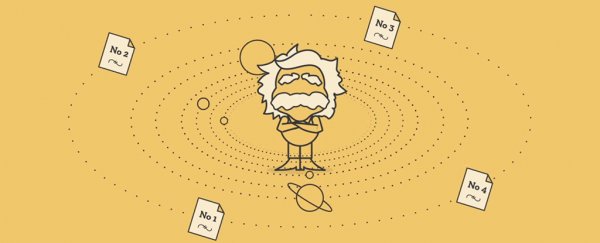
At the start of 1905, Albert Einstein was an unknown physicist working six days a week at a Swiss patent office, but over the next 12 months he published four momentous scientific papers, each of which would transform our ideas about the Universe.
Scientists call it his annus mirabilis (or his "miracle year", for non-Latin speakers) and the TED-Ed video above explains just how mind-blowing Einstein's 1905 papers actually were.
Any scientist would have been happy to come up with just one of these ideas, but Einstein achieved all four in an incredible burst of inspiration: he tackled big questions on light particles, the existence of atoms, special relativity, and mass-energy equivalence (which is where the famous E=mc2 equation comes from).
Let's tackle light first, which back in 1905 was thought to travel in waves, with crests and troughs. Not so, Einstein argued in a March 1905 paper.
Actually, he said, it's made up of localised particles - a finite number of photons spreading through space.
His hypothesis explained the photoelectric effect, where light beams release electrons from a material, but it was so revolutionary that it wouldn't be widely accepted for another 20 years.
Today, Einstein's discovery is a cornerstone of wave-particle duality, the quantum-level concept that light can be both a wave and a particle.
But Einstein was just getting started. His next paper, in May 1905, looked at the question of whether atoms actually existed - something that scientists had been debating for centuries.
Here Einstein used the phenomena of Brownian motion - the movement of small particles in a liquid - to show that atoms were well and truly present, with millions of them causing the particles to bounce around.
Later experiments showed Einstein's calculations were correct, and he had another hit on his hands.
And yet the man kept going. In June 1905, he came up with his revolutionary hypothesis concerning special relativity: a way to reconcile two competing ideas about whether absolute motion could be defined.
Einstein's ingenious solution only applies in special cases, which is why it's called special relativity, but it supposes that the speed of light is constant while both time and space are relative to the observer.
A simple way to think about it is with a ship out at sea and someone watching it from the dock. If a sailor drops a rock from the top of the mast, to him it goes straight down and lands at the bottom of the mast, but to the observer on shore, it travels at an angle to keep up with the pace of the ship.
The ship metaphor, formulated by Italian scientist Galileo Galilei in 1632, is an example of what's called Galilean invariance - the idea that absolute motion can't be defined.
But Einstein had a problem with it, as it had already been established that the speed of light was constant, so replacing the rock with a beam of light messed up the hypothesis.
Because the speed of light is constant, the light lands on deck at the same time for both the sailor and the observer on land, but for the person on the dock, it travels a longer distance, so something doesn't fit.
That's when Einstein decided both space and time could be stretched, and it's thanks to this idea - special relativity - that we have everything from particle accelerators to GPS satellites.
Finally, Einstein published a fourth paper in September 1905, a kind of add-on to his special relativity paper.
After some more thinking, Einstein had concluded that special relativity also indicated a fixed relationship between mass and energy: E=mc2, or energy equals mass multiplied by the square of the speed of light.
The hypothesis means that as objects approach the speed of light, their mass increases. Einstein was the first to identify the link between the two - a relationship which today helps us understand nuclear reactions and many more aspects of physics.
All in all, not bad for a year's work, although Einstein still had plenty of innovative ideas yet to come.
Let's hope he had time to enjoy a drink as 1905 turned into 1906 - he'd certainly earned one.
